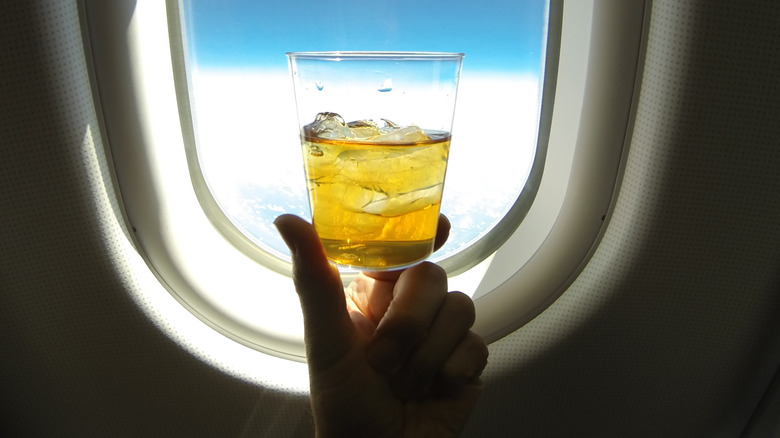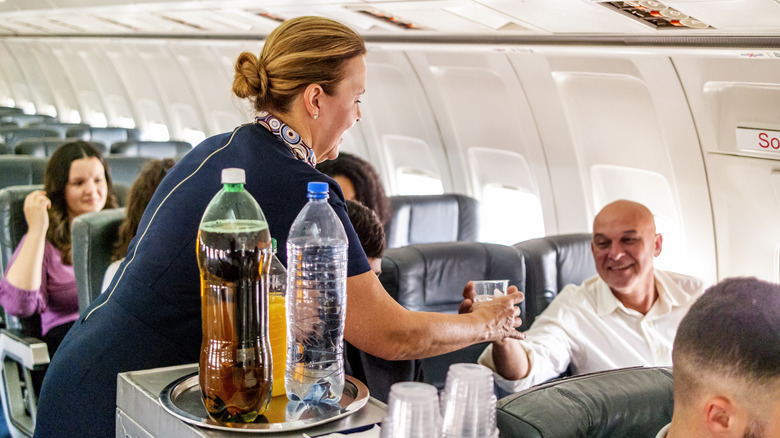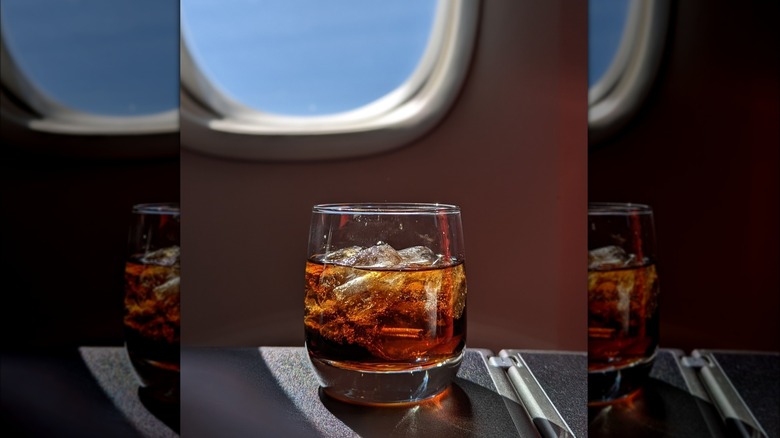Is It A Bad Idea To Order Your Drink With Ice On A Plane
There's nothing like sipping a complimentary beverage poured into a little plastic cup while you soar 30,000 feet in the air. However, that small luxury you enjoy while sitting in a cramped airplane seat may actually contain a whole lot of germs. Before you order your Diet Coke with extra ice on your next flight, you might want to reconsider those ice cubes.
Planes encounter a whole lot of germs with every new group of travelers that boards, and not every surface is as clean as we might hope. With all the safety checks that flight attendants must complete within a time crunch between scheduled flights, there is only so much time available to sanitize surfaces and supplies — including things like silverware and ice scoops. Even renowned chef Gordon Ramsay refuses to eat on planes because they're historically kind of unsanitary, so clearly, here is something to be said about being cautious when accepting food or drink served on an airplane — especially ice.
While ice doesn't really go bad if it stays frozen, it can develop unwanted flavors and even bacteria when stored improperly or exposed to germs. Ice made on planes has a reputation for being made from potentially bacteria-filled water, which is then exposed to germ-filled air inside the closed quarters of a plane — not to mention how many people handle it during service.
Plane water isn't exactly the cleanest
The ice served on planes is either made on the plane itself with an onboard ice machine, or imported from off-site and loaded onto planes before takeoff. If the ice is made onboard, it comes from the aircraft's tap water. Given that airlines are only required to clean and disinfect an airplane's water tank four times a year, bacteria has plenty of time to grow and find its way into the ice cubes. A 2019 study conducted by CUNY's Hunter College found that most airlines did not score above a 3 on a 0–5 rating scale for onboard water cleanliness and consumer safety, raising concerns about potential E. coli outbreaks passed through a plane's water and, by extension, the ice made from that water.
Even when ice is brought from off-site, there's still room for contamination, considering how many hands handle the bag before it arrives on board. Once the ice is in the cabin, multiple flight attendants reach into the ice to serve each passenger. According to one flight attendant on Reddit, "We don't have the opportunity to wash our hands at all during the beverage service." This alone might make you think twice about accepting that complimentary beverage.
You can technically bring your own ice onto airplanes
If you absolutely cannot enjoy a beverage without a few ice cubes to cool it down, there is a way to bring your own from home. While each country has specific travel rules, the United States enforces strict guidelines on what you can and cannot bring onto a plane. Most people passing through the Transportation Security Administration (TSA) are reminded they cannot bring in liquids of any kind for security reasons. However, you can bring ice, since it is technically considered a solid in its frozen state.
To get homemade ice through security, make sure it remains completely frozen as you pass through. If the ice melts even slightly and has a measurable amount of water pooling at the bottom of your container, TSA will require you to throw it out. It's recommended to pack your ice in a well-insulated container that will keep it cold enough to stay frozen throughout your travels.



